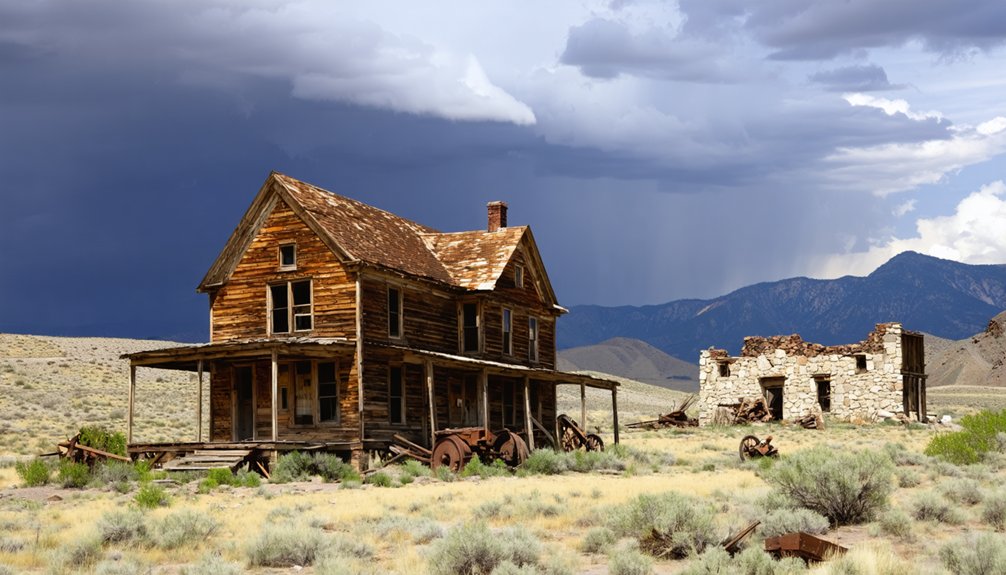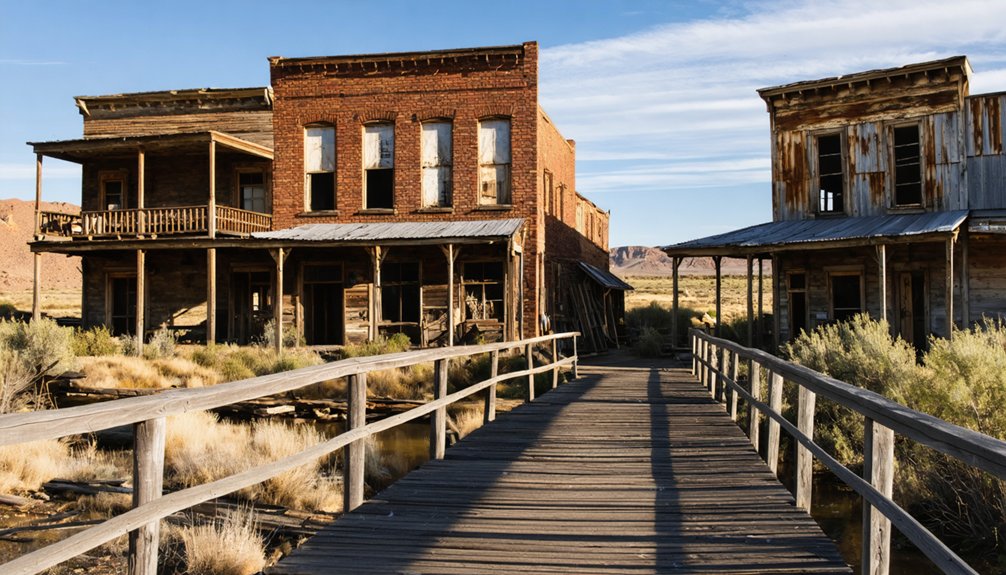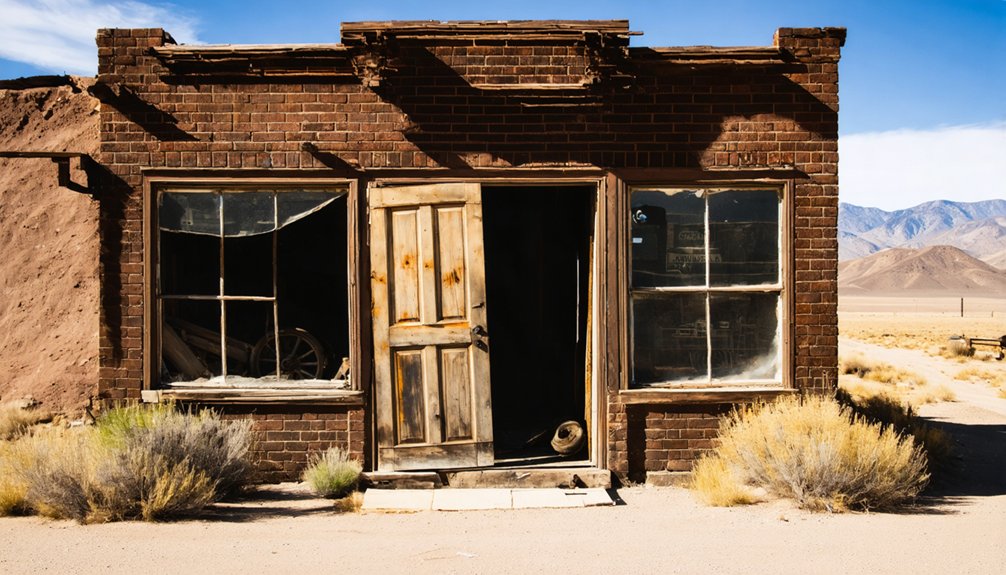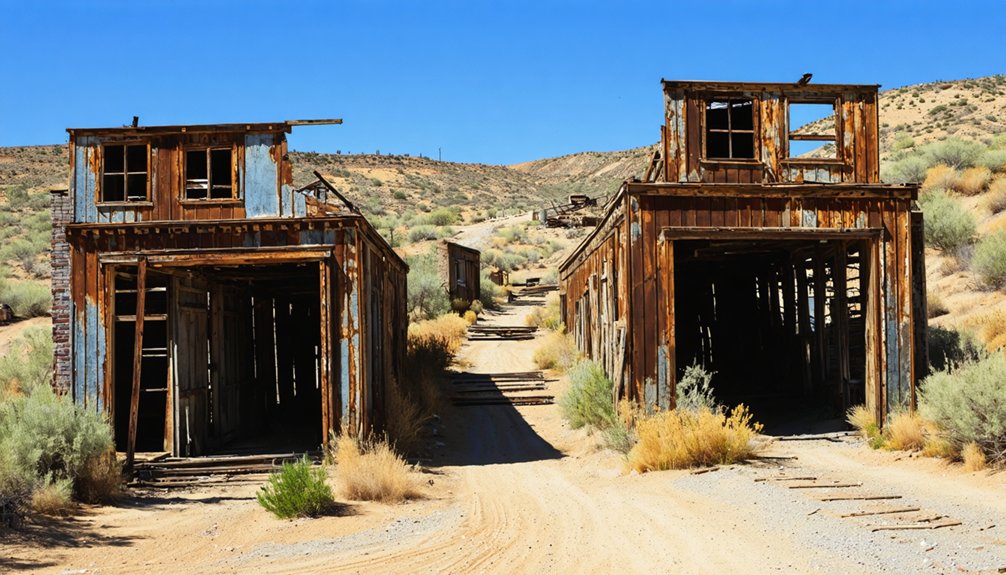You’ll find De Lamar nestled in Idaho’s Owyhee Mountains, where Captain Joseph De Lamar transformed a silver discovery into an $8 million mining empire in 1888. At its peak, over 1,000 residents called this frontier boomtown home, complete with schools, businesses, and advanced mining operations. After the 1893 silver crash, the town gradually declined into abandonment. Today, while most structures remain on private mining property, De Lamar’s remarkable story of boom and bust awaits exploration.
Key Takeaways
- De Lamar was a prosperous Idaho mining town established in 1888, reaching a peak population of over 1,000 residents during the silver boom.
- The town thrived under Joseph R. DeLamar’s leadership, featuring advanced mining operations, stamp mills, and complete community infrastructure.
- Following the 1893 silver crash and resource depletion, De Lamar gradually declined and was abandoned by the mid-20th century.
- Historic structures remain but are largely inaccessible, as they’re located within private property containing modern mining operations.
- The ghost town’s linear layout stretched two miles along Jordan Creek, featuring frontier architecture and a brick schoolhouse.
The Birth of a Silver Mining Boomtown
While gold was initially discovered along Jordan Creek near Wagontown in 1863, De Lamar’s true genesis as a silver mining boomtown didn’t begin until J.W. Stoddard located a significant lode in 1875.
The DeLamar Legacy truly took shape when Joseph R. DeLamar arrived from Leadville in 1886, bringing advanced Mining Techniques to the Wilson Mine. The area would later be evaluated using NI 43-101 standards to assess its mineral wealth.
You’ll find that DeLamar’s strategic moves transformed the region. He quickly acquired the Wilson Mine, purchased a mill in Silver City, and by 1887, developed the lode for major production.
His vision culminated in 1888 with the establishment of De Lamar town and installation of a large stamp mill. The settlement expanded rapidly, featuring a complete mining plant with hotels, offices, shops, and housing for the 200-strong workforce that would shape the area’s destiny.
Captain De Lamar’s Vision and Investment
Before establishing himself as a mining magnate, Joseph Raphael De Lamar built his expertise through an unconventional path, shifting from maritime trades to mining ventures. His investment strategies began with private chemistry studies and a modest $5,500 purchase of Colorado’s Terrible Lead Mine, which he later sold for $130,000. This success fueled his vision for mining sustainability in Silver City, Idaho. During his early career as a master ship captain, he developed the leadership skills that would later serve him in managing large-scale mining operations.
You’ll find De Lamar’s legacy in the extensive facilities he developed near Silver City, where he built more than just mines. He created a self-sustaining community with mills, hotels, stores, and tramways, employing 200 workers.
His operation attracted British investors, who paid $2 million for a half interest after he’d already extracted $1.5 million in precious metals, proving his ventures weren’t just profitable—they were transformative. His mining revival in 1888 generated impressive dividends of 112% for investors.
Peak Years of Prosperity (1888-1893)
During De Lamar’s peak years from 1888 to 1893, you’d find a bustling town of over 1,000 residents supported by one of Idaho’s most productive silver mining operations.
You could witness significant technological advancement through the installation of large stamp mills, which processed ore from the De Lamar Mine and neighboring claims worth approximately $8 million in silver output.
Walking through town, you’d encounter a thriving business district along Jordan Creek, complete with hotels, saloons, a newspaper office, and essential services, while the notorious “Tough Town” district housed the town’s more controversial establishments. Visitors today enjoy exploring these well-preserved buildings that offer a glimpse into the silver mining era.
Mining Innovation and Investment
As the late 1880s ushered in a new era of mining prosperity, De Lamar’s operations underwent significant technological and financial transformation.
You’d find cutting-edge mining technology throughout the operation, including a state-of-the-art stamp mill capable of processing 150 tons of ore daily, powered by a 250 horsepower Corliss engine. The introduction of the Peloton-Clerici cyanide process revolutionized ore treatment efficiency, while a three-rail gravity tramway streamlined logistics. The mine’s rich deposits yielded valuable silver and gold that would later support decades of modern open-pit operations.
The venture’s economic sustainability received a major boost when Captain De Lamar consolidated numerous claims into the De Lamar Mining Company.
Booming Population Growth
The rapid influx of fortune-seekers and miners transformed De Lamar into a bustling boomtown between 1888 and 1893, with its population rivaling that of nearby Silver City.
Population dynamics reflected the area’s economic importance, as Owyhee County’s numbers swelled from 2,021 in 1890 to nearly 5,000 by 1896. The demographic trends showed seasonal fluctuations, with summer months bringing heightened activity and workforce expansion.
You’d have found a diverse community of mining laborers, mill workers, and entrepreneurs who established boarding houses, businesses, and homes. The town’s growth was fueled by discoveries like the Morning Star quartz mill, which pioneered mineral processing in the region.
The development of infrastructure, including telephone lines and improved roads, supported this growth. De Lamar’s prosperity attracted substantial investment capital from Chicago, which funded advanced mining operations and created numerous jobs that sustained the town’s expanding population.
Bustling Commercial District
De Lamar’s expanding population needed a robust commercial hub, and they found it along Jordan Creek in an area that became known as “Tough Town.”
This bustling district paralleled the waterway, featuring a strategic mix of mining supply shops, saloons, and boarding houses that served the town’s growing workforce.
The commercial growth centered around Joseph R. De Lamar‘s stamp mill operations, which attracted significant investment capital from Chicago and later London.
Community dynamics thrived as merchants, entrepreneurs, and colorful characters like Jennie Mitchell established businesses catering to miners’ needs.
- Livery barns supported crucial transportation for both freight and passengers
- Mining supply shops and general stores provided essential equipment and daily necessities
- Entertainment venues, including saloons and houses of ill-repute, offered miners after-hours diversions
Life in a Rugged Mining Community

Life in De Lamar demanded exceptional resilience from its inhabitants, who faced daily challenges in this isolated mining settlement.
In De Lamar’s unforgiving terrain, settlers forged ahead through isolation and hardship, their resilience becoming the backbone of survival.
You’d find a tight-knit community where cultural identity centered on shared hardships and mutual support. As a miner, you’d work grueling shifts, battling dangerous conditions while extracting silver from deep within the earth.
Your social standing would largely depend on your occupation, with clear divisions between business owners, miners, and those who inhabited “Tough Town.” If you were Basque, you’d join a proud community known for their work ethic.
After long days in the mines, you’d seek entertainment in the town’s saloons and gambling halls. Despite the harsh conditions and basic amenities, community resilience shone through as residents banded together, creating a self-sufficient society in this rugged frontier outpost.
The Silver Crash and Economic Impact
During 1893’s devastating silver crash, you’d witness the dramatic unraveling of De Lamar’s economic foundation as silver prices plummeted nationwide. The repeal of the Sherman Silver Purchase Act triggered severe silver market fluctuations, forcing many mines in the Owyhee Mountains to shut down or drastically reduce operations.
Economic diversification challenges hit the remote mining town particularly hard, as De Lamar’s isolation left few alternatives for sustaining its economy.
- Mining families faced unprecedented hardship as jobs disappeared and the town’s prosperity quickly faded.
- The crash’s impact was intensified by De Lamar’s geographic isolation and dependence on a single industry.
- Local businesses struggled to survive as the mining community’s purchasing power diminished rapidly.
Though some mining continued at a reduced scale, the silver crash marked the beginning of De Lamar’s gradual descent into ghost town status.
Architecture Along Jordan Creek

Nestled within a narrow canyon, De Lamar’s architecture adapted to the challenging terrain along Jordan Creek, with buildings aligning both sides of the main road and climbing the steep hillsides.
You’ll find the town stretched about two miles as a linear settlement, primarily two rows wide, showcasing frontier architectural styles from the mining era. De Lamar’s peak operations yielded an impressive million dollars monthly in silver production.
While most structures featured practical wood-frame construction, you’ll discover notable exceptions like the brick schoolhouse funded by Captain DeLamar. Similar to Silver City’s historic district, the area maintains much of its original 1860s appearance.
The town’s historic preservation efforts have maintained many original buildings, from simple rectangular designs with pitched roofs to more elaborate residences like the Stoddard House, complete with fine wooden trim and decorated wallpaper.
Modern amenities, including telephone lines and electricity, were integrated early on, making De Lamar surprisingly advanced for its frontier setting.
The Red Light District and “Tough Town”
Along Jordan Creek’s lower section, “Tough Town” emerged as De Lamar’s entertainment district, where saloons and brothels operated openly to serve the mainly male mining population.
You’ll find that this area became notorious for its red-light district, which featured several prominent establishments including what historical accounts describe as “one of the largest houses of ill-repute in De Lamar.”
Law enforcement faced significant challenges in this bustling vice district, where the isolation of the mining town and the demands of its workforce contributed to a permissive atmosphere toward gambling, prostitution, and other illicit activities. Similar to other frontier towns in the American West, the women who worked there were commonly known as soiled doves, a euphemism that reflected their marginalized status in society.
Vice and Entertainment Venues
The rough-and-tumble section of De Lamar known as “Tough Town” served as the mining camp‘s vice and entertainment hub, positioned at a sharp bend of Jordan Creek away from the main business district.
As you explore the red light history of this frontier town, you’ll find that Tough Town catered to the needs of the mainly male mining population, featuring livery barns, saloons, and a thriving red-light district.
- Jennie Mitchell ran one of the largest houses of ill-repute, having relocated her operation from Hailey.
- The infamous Long-tow Liz was a well-known figure in Mitchell’s establishment.
- Local authorities typically turned a blind eye to these activities, following the common practice in western mining towns.
Today, the physical remnants of these once-bustling establishments lie on private property within a modern mining operation.
Law Enforcement Challenges
Despite attempts to maintain order, law enforcement faced significant challenges in De Lamar’s notorious “Tough Town” district during the mining camp’s heyday.
With no dedicated police station or jail within town limits, authorities relied heavily on informal justice and mining security to maintain some semblance of control. You’d find law enforcement stretched thin, with the nearest official presence located six miles away in Silver City.
The town’s demographic makeup complicated matters further. A volatile mix of transient miners, gamblers, and sex workers, combined with numerous saloons and brothels, created a powder keg of potential conflicts.
In the absence of formal policing, residents often resorted to self-policing methods, while influential figures in the vice trade, like Jennie Mitchell, wielded considerable unofficial authority in the district.
Gradual Decline Into Abandonment

Once silver prices crashed in 1893, De Lamar’s fate was sealed, triggering a gradual exodus of its residents and businesses. The town’s extreme mining dependency left it vulnerable, with no alternative industries to sustain its declining population.
The silver crash of 1893 doomed De Lamar, as its single-industry economy couldn’t survive without the precious metal’s prosperity.
You’ll find that what was once a bustling community of over 1,000 residents slowly transformed into a shell of its former self.
- The summer-only post office that operated until 1930 marked one of the last remaining services
- Hotels, saloons, and other businesses that once served the mining community were abandoned
- The town’s remote location in the Owyhee Mountains made it difficult for remaining residents to establish new economic opportunities
Today, you’ll discover that De Lamar’s remains sit on private property, serving as a reflection of the risks of building an economy on a single industry.
Preserved Structures and Historic District
While De Lamar’s decline led to widespread abandonment, remnants of this historic mining settlement still dot the landscape, though they’re now largely inaccessible to the public.
You’ll find the remaining structures within a modern open-pit mining operation on private property, making ghost town exploration virtually impossible.
Unlike nearby Silver City, which enjoys active historic preservation and welcomes visitors, De Lamar lacks formal historic district designation or organized preservation efforts.
The few surviving buildings continue to deteriorate without protection, their historical significance fading with each passing year.
You can draw a stark contrast with Nevada’s Delamar Ghost Town, where extensive ruins remain available for public viewing.
De Lamar’s private ownership and active mining operations create unique challenges for preserving this piece of Idaho’s mining heritage.
Planning Your Visit to De Lamar Today
Before planning a visit to De Lamar, you’ll need to recognize its strict accessibility limitations as an active mining site on private property. Access considerations require you to verify current entry permissions and respect all posted restrictions.
The site’s remote location demands careful preparation, including a reliable vehicle and essential supplies.
- You’ll need to navigate county roads to reach the area, though a high-clearance vehicle is recommended for the rough terrain.
- Pack emergency supplies, water, and food since there aren’t any services or facilities nearby.
- Stay alert for mining hazards and unstable ground while following all safety precautions.
Given the site’s industrial nature and safety concerns, you’ll want to contact local authorities before attempting any exploration.
Remember that cell service is nonexistent, so self-reliance is vital for any visit.
Frequently Asked Questions
Were There Any Notable Crimes or Shootouts in De Lamar’s History?
You won’t find many documented crime incidents or shootout stories from De Lamar’s past. While general lawlessness existed in the mining town, specific violent events weren’t well-recorded in historical accounts.
What Was the Average Worker’s Daily Wage in De Lamar’s Mines?
You’d have found miners earning approximately $2-4 per day during De Lamar’s peak mining economy, though wage history records aren’t definitive and pay varied based on skill and market conditions.
Did Any Famous People Besides Captain De Lamar Visit the Town?
Beyond Captain DeLamar, you won’t find many famous historical figures in visitor tales. The only notable personalities were Jennie Mitchell and “Long-tow Liz,” who ran the town’s red-light district.
What Happened to the Mining Equipment After the Town Was Abandoned?
Ever wonder about abandoned mining machinery’s fate? You’ll find most equipment was left to decay, with some parts salvaged by local miners. The heavy machinery was later scrapped, while shafts were sealed or collapsed.
Were There Any Major Fires or Natural Disasters in De Lamar?
While historical records don’t mention significant fire impact or disaster recovery efforts, you’ll find no documented evidence of major natural disasters in the town’s narrow creek bottom location.
References
- https://en.wikipedia.org/wiki/De_Lamar
- https://idaho.com/history/de-lamar/
- https://westernmininghistory.com/towns/idaho/de-lamar/
- https://history.idaho.gov/wp-content/uploads/2018/09/Delamar_Historic_District_76000679.pdf
- https://www.ghosttowns.com/states/id/delamar.html
- http://www.ghosttowngallery.com/htme/delamar.htm
- https://www.familysearch.org/en/wiki/De_Lamar
- https://www.atlasobscura.com/places/delamar-ghost-town
- https://integraresources.com/asset/delamar-project/
- https://www.idahogeology.org/Uploads/Data/MineDocs/BO0100_009.pdf



